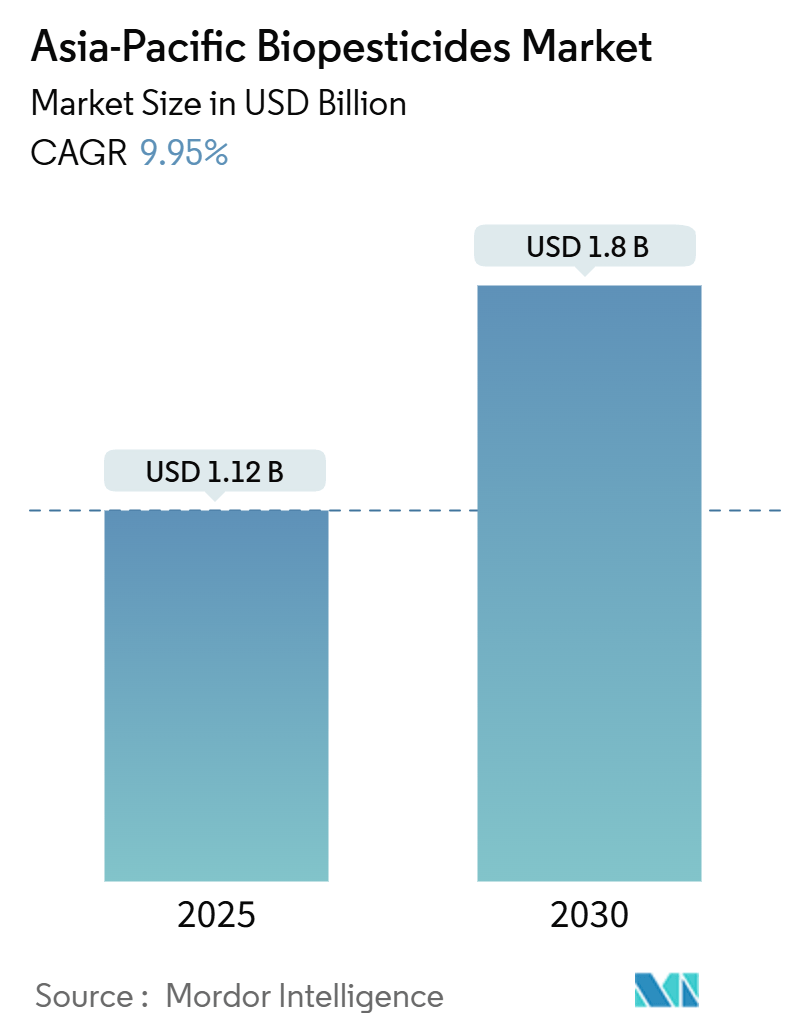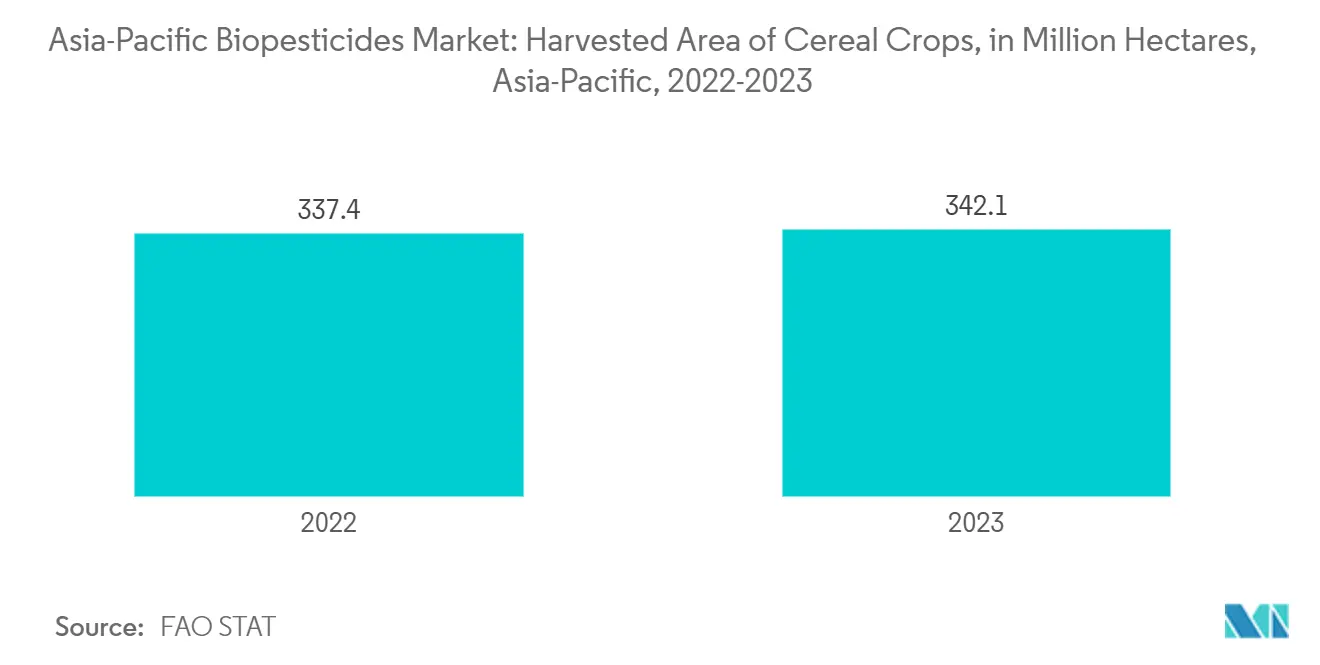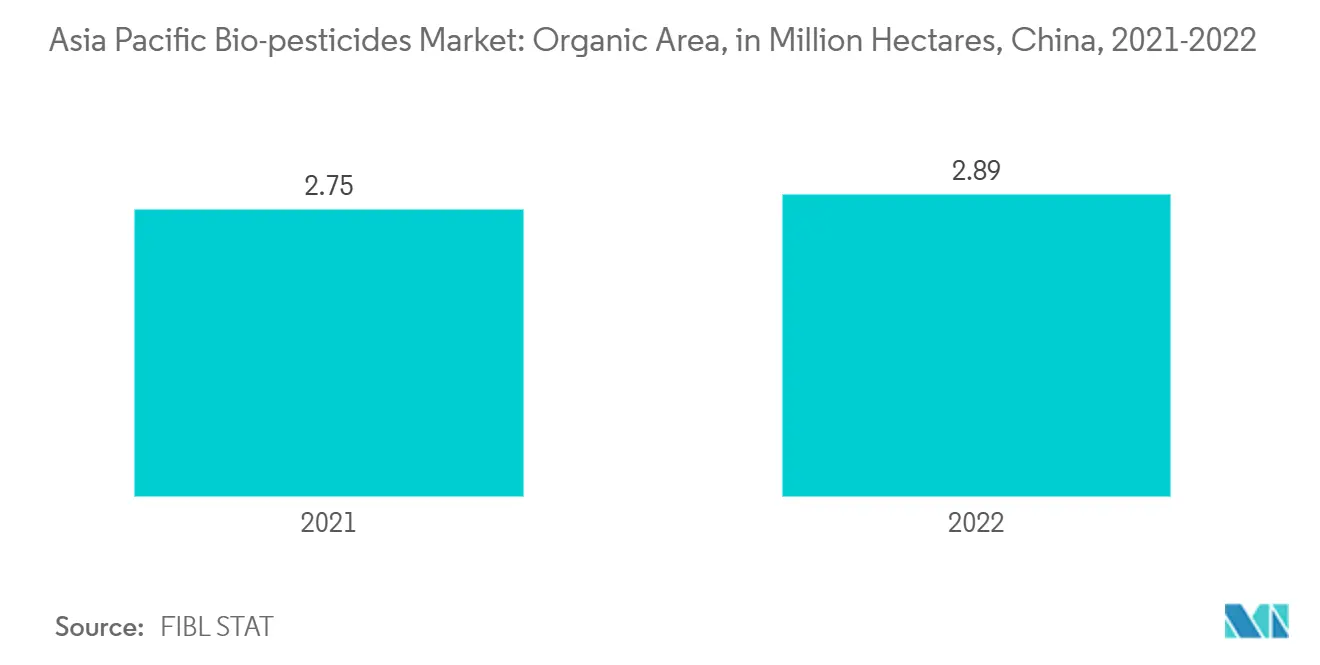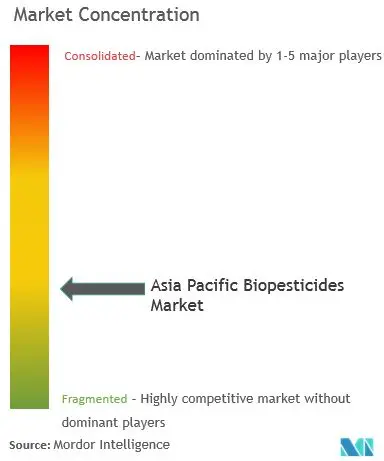
Asia-Pacific Biopesticides Market Analysis by Mordor Intelligence
The Asia-Pacific Biopesticides Market size is estimated at USD 1.12 billion in 2025, and is expected to reach USD 1.8 billion by 2030, at a CAGR of 9.95% during the forecast period (2025-2030).
The Asia-Pacific biopesticides market is experiencing significant growth, driven by the increasing adoption of organic farming practices. The area dedicated to organic farming in the region increased from 6.4 million hectares in 2021 to 8.8 million hectares in 2022, representing a 37.5% growth during this period, according to FiBL STAT. This trend reflects growing consumer demand for chemical-free produce, prompting farmers to seek biopesticide alternatives to synthetic pesticides.
Government initiatives are playing a crucial role in promoting biopesticides. According to the Ministry of Agriculture & Farmers Welfare, India has implemented schemes such as Paramparagat Krishi Vikas Yojana (PKVY), which allocated USD 52.6 million as of 2023, and Mission Organic Value Chain Development for North Eastern Region (MOVCDNER). These programs provide incentives to farmers for producing and using organic inputs through Direct Benefit Transfer (DBT). Japan has also emphasized integrated pest management strategies, encouraging broader adoption of biopesticides among farmers.
Despite the promising outlook, challenges remain. Many farmers are resistant to transitioning from conventional chemical pesticides to biopesticides due to a lack of awareness about their benefits and concerns over efficacy. The Asia-Pacific biopesticides market is poised for growth due to increasing organic cultivation areas and supportive government policies. However, addressing farmer resistance through education and demonstrating the effectiveness of biopesticides will be critical for sustained market expansion.
Asia-Pacific Biopesticides Market Trends and Insights
Biofungicides Segment Dominate the Market
Bacillus, Trichoderma, Streptomyces, and Pseudomonas are the primary microorganisms used commercially as biofungicides in agriculture. These biofungicides effectively control pathogens, including Pythium, Rhizoctonia, Fusarium, Sclerotinia, Thielaviopsis, Botrytis, and powdery mildew.
The bio fungicides segment dominates the Asia-Pacific biopesticides market due to several factors. With increasing awareness of sustainable agricultural practices, farmers are adopting bio fungicides as a safer alternative to chemical fungicides. Cereals such as wheat, rice, and maize are the most commonly affected crops by fungal infections. The extensive cultivation area of these crops in the region drives biofungicide demand. For instance, the harvested area of cereal crops in Asia increased from 337.4 million hectares in 2022 to 342.1 million hectares in 2023, contributing to higher biofungicide demand in the region.
Another significant driver is the effectiveness of biofungicides in managing crop diseases. Research indicates that bio fungicides provide effective disease control while enhancing soil health and biodiversity. The FAO reports that using biopesticides results in healthier crops and improved yields, making them an attractive option for farmers seeking to optimize their production.
The dominance of the bio fungicides segment in the Asia-Pacific biopesticides market results from growing environmental awareness, supportive government policies, and proven efficacy in disease management. As these factors continue to align, the demand for bio fungicides is expected to increase, strengthening their position in sustainable agriculture practices across the region.

China Dominates the Market
China leads the Asia-Pacific biopesticides market, supported by its position as the region's largest producer and consumer of agricultural crops. With vast farmlands dedicated to staples such as rice, wheat, and corn, the country significantly influences the demand for biopesticides. According to FAOSTAT, China's cereal production increased from 634.9 million metric tons in 2022 to 643.4 million metric tons in 2023, demonstrating its focus on agricultural productivity. The organic area in the country expanded from 2.75 million hectares in 2021 to 2.89 million hectares in 2022, according to FIBL STAT. This growth drives the adoption of biopesticides, as farmers seek to improve crop protection and yield while reducing chemical inputs.
China's emphasis on sustainable agriculture propels biopesticide adoption. The government's "Agriculture Green Development (2021-2025)" initiative promotes eco-friendly practices, including the use of bio-based solutions like biopesticides. These efforts address challenges such as soil degradation, pollution, and water scarcity by reducing reliance on chemical pesticides and fertilizers. Biopesticides support soil health and environmental pest management in China's agricultural sector.
Regulatory policies strengthen the biopesticides market in China. The government has implemented measures to limit chemical pesticide usage, improve crop quality, and reduce environmental harm. The World Bank's USD 320 million loan for green agriculture and rural development in Southwest China aligns with the National Rural Revitalization Program (2018-2035), increasing investments in sustainable agricultural practices. These initiatives accelerate the adoption of biopesticides for environmentally safe crop management.
China's agricultural policies, farming operations, and sustainability commitment establish its position in the Asia-Pacific biopesticides market. The country's focus on efficiency and environmental protection maintains its market leadership.

Competitive Landscape
The Asia-Pacific Agricultural Enzymes Market is fragmented. Major companies operating in the region include BASF SE, Bayer AG, Valent BioSciences LLC, Emery Oleochemicals, and Gujarat State Fertilizers & Chemicals Ltd. These companies are adopting various strategies, such as product launches, partnerships, and acquisitions, to gain a larger share of the market.
Asia-Pacific Biopesticides Industry Leaders
BASF SE
Valent Biosciences LLC
Bayer AG
Gujarat State Fertilizers & Chemicals Ltd
Emery Oleochemicals
- *Disclaimer: Major Players sorted in no particular order

Recent Industry Developments
- April 2024: Bayer entered into an agreement with AlphaBio Control, a UK-based company, to obtain an exclusive license for a new biological insecticide. The product will be the first biological insecticide available for arable crops, specifically oilseed rape and cereals. The initial product launch is scheduled for 2028, subject to development completion and regulatory registration.
- February 2024: Syngenta Crop Protection and Lavie Bio Ltd., a subsidiary of Evogene Ltd., established an agreement to discover and develop new biological insecticidal solutions. The collaboration combines Lavie Bio's technology platform for identifying and optimizing bio-insecticide candidates with Syngenta's global research, development, and commercialization capabilities.
Asia-Pacific Biopesticides Market Report Scope
Biopesticides are living organisms which can intervene in the life cycle of insect pests in such a way that crop damage is minimized. The agents employed as biopesticides are parasites, predators, fungi, bacteria and viruses which are natural enemies of pests. These bioagents can be conserved, preserved and multiplied under laboratory conditions for field release. The Asia-Pacific biopesticides market is segmented by Product (Bioherbicides, Bio insecticides, Bio fungicides, and Other Biopesticides), Application (Crop-based and Non-crop-based), and Geography (Australia, China, India, Japan, and Rest of Asia-Pacific). The report offers market estimation and forecast in value (USD) of the above-mentioned segments.
| Biopesticides | Bioherbicides |
| Bioinsecticides | |
| Biofungicides | |
| Other Biopesticides |
| Crop based | Grains and Cereals |
| Oil seeds | |
| Fruits and Vegetables | |
| Non-crop based | Turf and Ornamental Grass |
| Others |
| Asia-Pacific | Australia |
| China | |
| India | |
| Japan | |
| Rest of Asia-Pacific |
| Product | Biopesticides | Bioherbicides |
| Bioinsecticides | ||
| Biofungicides | ||
| Other Biopesticides | ||
| Application | Crop based | Grains and Cereals |
| Oil seeds | ||
| Fruits and Vegetables | ||
| Non-crop based | Turf and Ornamental Grass | |
| Others | ||
| Geography | Asia-Pacific | Australia |
| China | ||
| India | ||
| Japan | ||
| Rest of Asia-Pacific | ||
Key Questions Answered in the Report
How big is the Asia-Pacific Biopesticides Market?
The Asia-Pacific Biopesticides Market size is expected to reach USD 1.12 billion in 2025 and grow at a CAGR of 9.95% to reach USD 1.8 billion by 2030.
What is the current Asia-Pacific Biopesticides Market size?
In 2025, the Asia-Pacific Biopesticides Market size is expected to reach USD 1.12 billion.
Who are the key players in Asia-Pacific Biopesticides Market?
BASF SE, Valent Biosciences LLC, Bayer AG, Gujarat State Fertilizers & Chemicals Ltd and Emery Oleochemicals are the major companies operating in the Asia-Pacific Biopesticides Market.
What years does this Asia-Pacific Biopesticides Market cover, and what was the market size in 2024?
In 2024, the Asia-Pacific Biopesticides Market size was estimated at USD 1.01 billion. The report covers the Asia-Pacific Biopesticides Market historical market size for years: 2019, 2020, 2021, 2022, 2023 and 2024. The report also forecasts the Asia-Pacific Biopesticides Market size for years: 2025, 2026, 2027, 2028, 2029 and 2030.
Page last updated on:
Asia-Pacific Biopesticides Market Report
Statistics for the 2025 Asia-Pacific Biopesticides market share, size and revenue growth rate, created by Mordor Intelligence™ Industry Reports. Asia-Pacific Biopesticides analysis includes a market forecast outlook for 2025 to 2030 and historical overview. Get a sample of this industry analysis as a free report PDF download.



